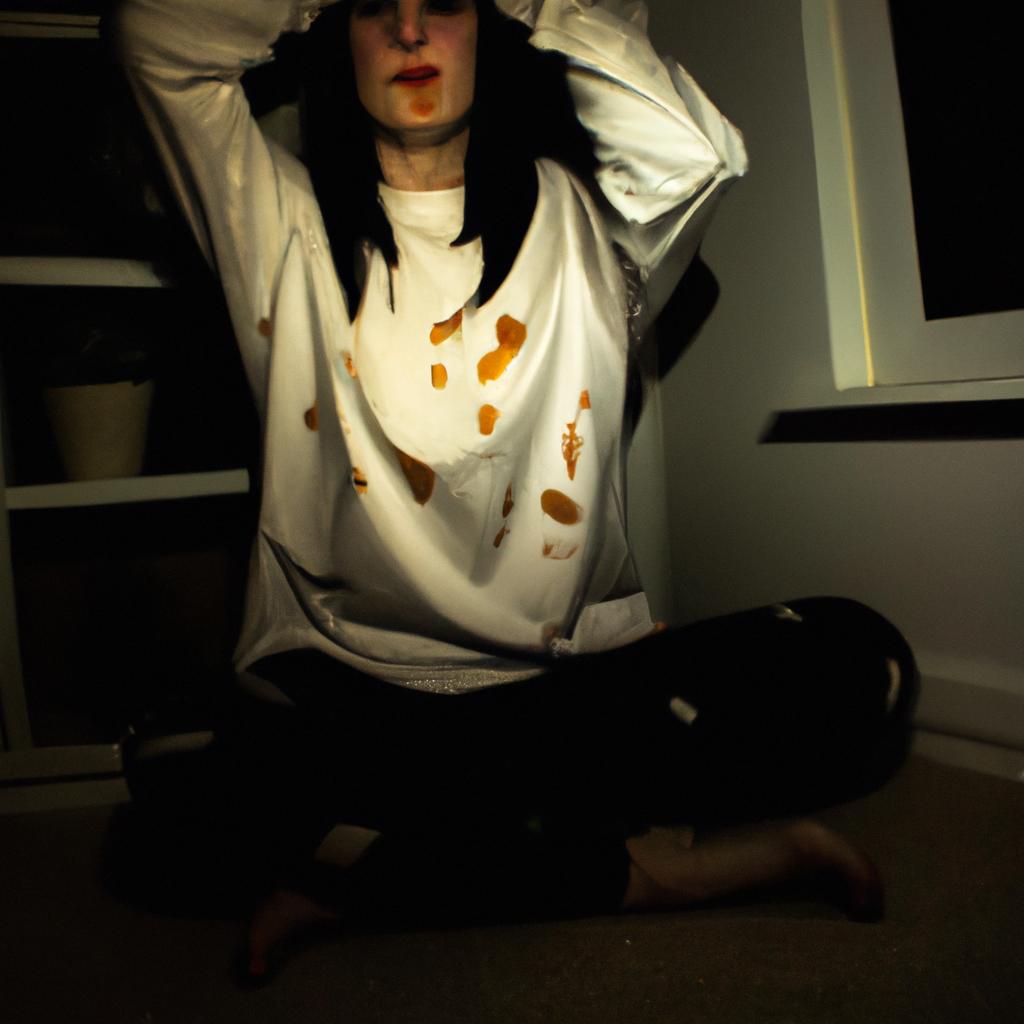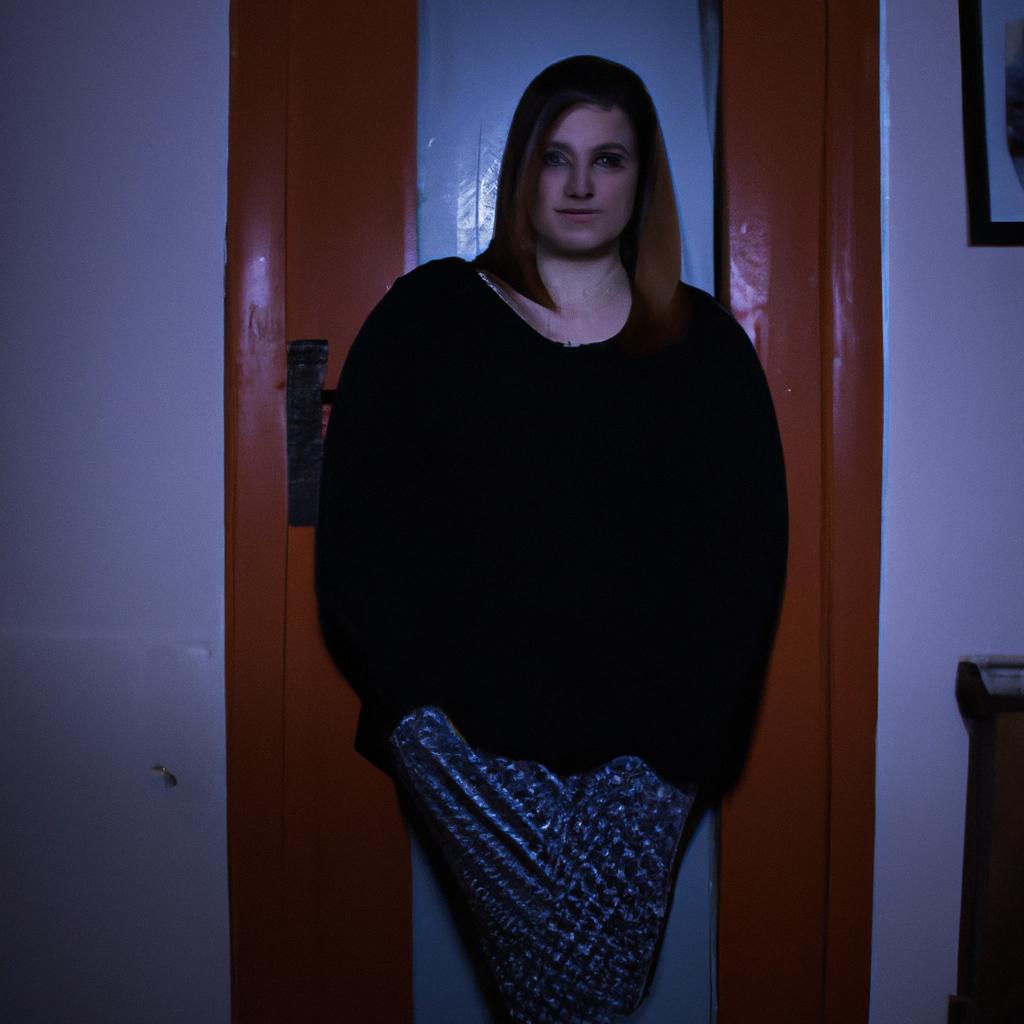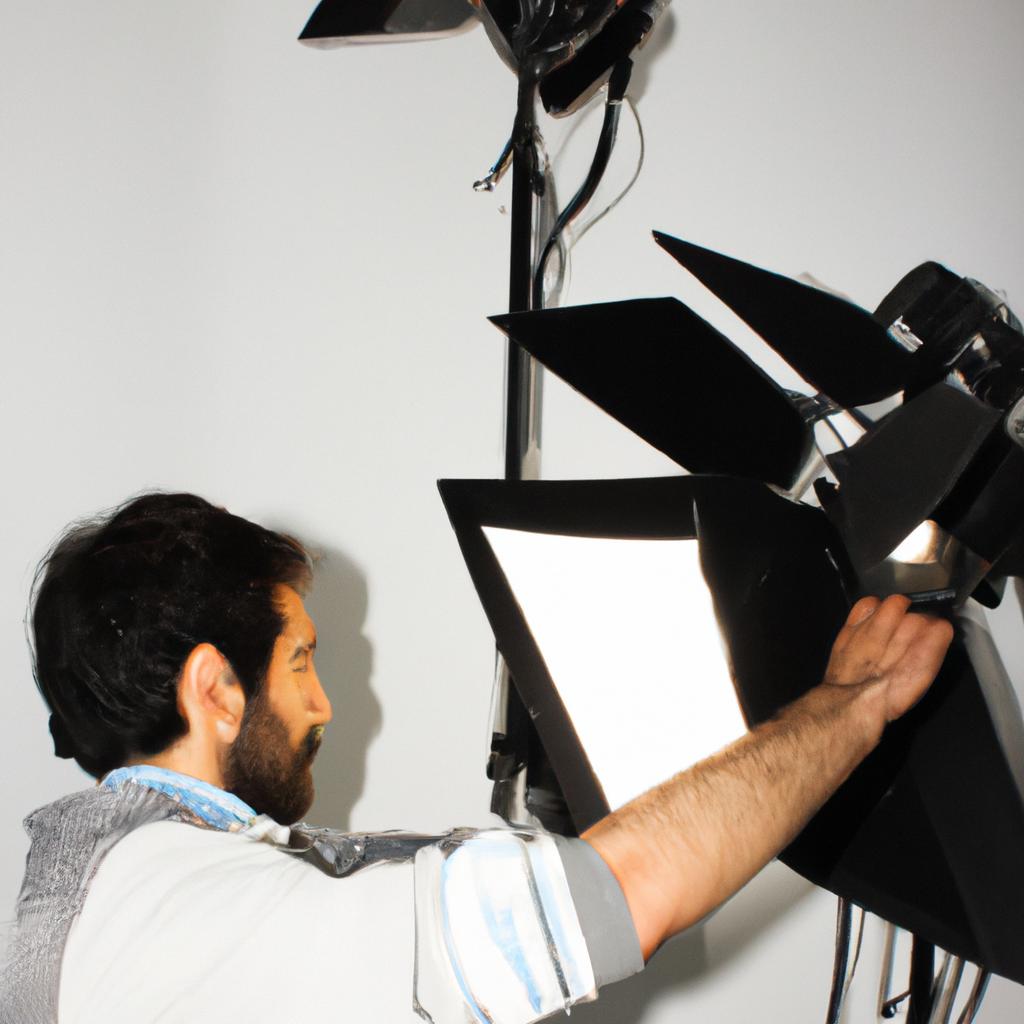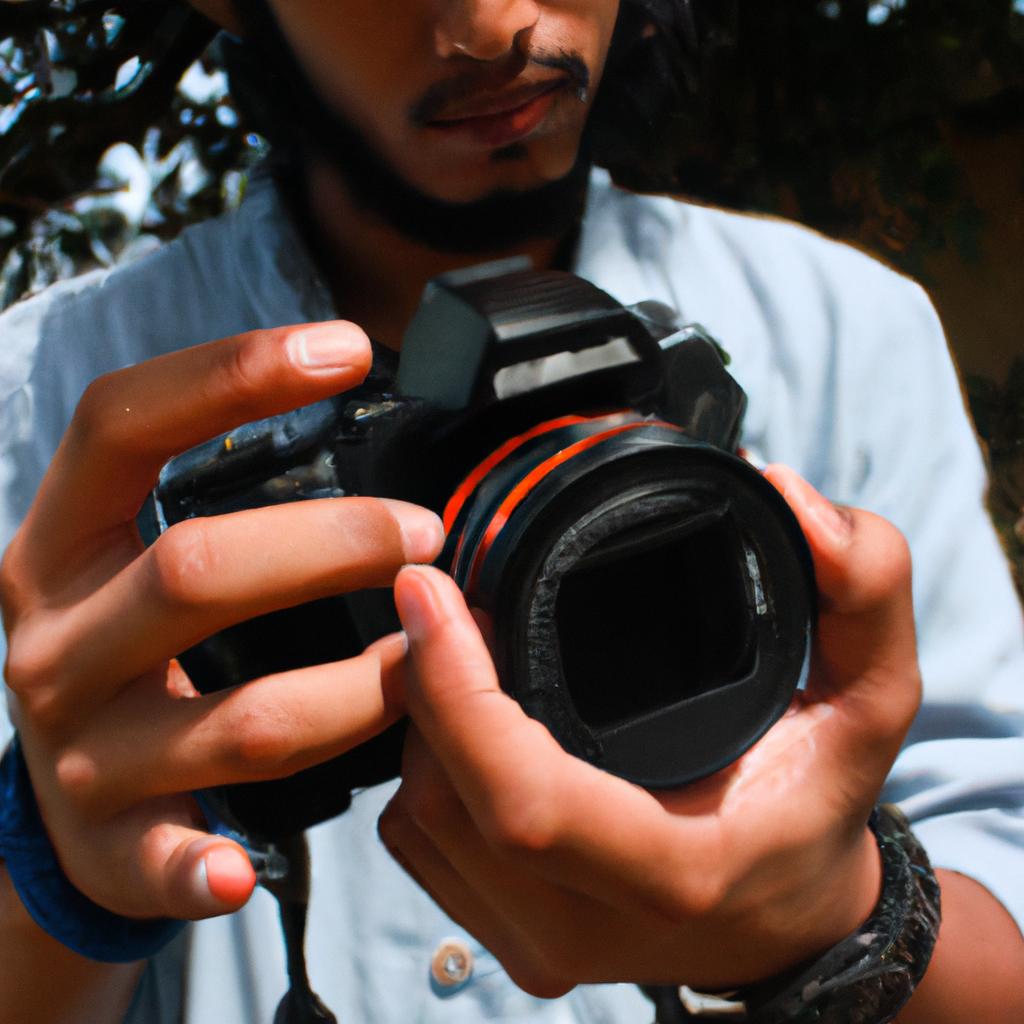In the world of photography, capturing intimate moments and evoking a certain mood is an art form that requires careful consideration of various elements. One such element that holds immense power in setting the ambiance and enhancing the visual appeal of boudoir photography is lighting. Creating captivating images in this genre necessitates mastering lighting techniques to convey sensuality, intimacy, and allure. For instance, imagine a scenario where soft, diffused light delicately falls on the subject’s contours, accentuating their curves while casting subtle shadows for a touch of mystery. Such expertise in manipulating light can transform ordinary portraits into stunning works of art.
The significance of proper lighting techniques cannot be overstated when it comes to boudoir photography. The interplay between light and shadow has the ability to shape the narrative within these photographs, as well as evoke specific emotions from viewers. By skillfully controlling factors like intensity, direction, color temperature, and diffusion, photographers can create a wide range of moods – from romantic and dreamy to seductive or even empowering. Each photograph becomes an opportunity for storytelling through carefully crafted illumination choices that guide the viewer’s gaze towards desired focal points while maintaining an air of elegance and sophistication. Understanding how different lighting setups interact with various body types and settings enables photographers to highlight the unique beauty of each individual and create a personalized experience for their clients.
One lighting technique commonly used in boudoir photography is called Rembrandt lighting. Named after the renowned painter, this technique involves positioning the main light source slightly above and to one side of the subject’s face, creating a triangular highlight on the cheek opposite the light source. This setup adds depth and dimension to the image, enhancing facial features while also adding a touch of drama.
Another popular lighting technique is called butterfly lighting or paramount lighting. In this setup, the main light source is positioned directly in front of the subject, slightly above eye level. By casting a soft, even light on the face, this technique creates a flattering and glamorous look that accentuates facial features and brings out natural beauty.
When it comes to setting up the overall ambiance in boudoir photography, controlling ambient light plays a crucial role. Depending on the desired mood and location, photographers may choose to utilize natural light from windows or incorporate artificial lighting such as strobes or continuous lights. Balancing these different sources of light allows photographers to sculpt shadows and highlights precisely as desired.
In addition to traditional lighting techniques, creative use of props like sheer curtains or strategically placed blinds can add an element of playfulness or mystery to boudoir photographs. These elements interact with the available light sources and further enhance their impact on the overall composition.
Ultimately, mastering lighting techniques in boudoir photography requires practice, experimentation, and an understanding of how different lighting setups can influence mood and storytelling within each photograph. With skillful control over illumination choices, photographers can create captivating images that celebrate intimacy while maintaining an atmosphere of elegance and artistry.
Understanding the importance of mood in boudoir photography
Understanding the Importance of Mood in Boudoir Photography
Boudoir photography is an art form that aims to capture intimate and sensual moments, often showcasing the beauty and confidence of individuals in a private setting. One key element that sets boudoir photography apart from other genres is its emphasis on creating a specific mood or atmosphere. The ability to evoke emotions through lighting techniques plays a crucial role in achieving this desired mood.
To illustrate the significance of mood in boudoir photography, let’s consider a hypothetical scenario. Imagine a photographer who wants to convey feelings of romance and passion in their images. By utilizing soft, warm lighting with gentle shadows, they can create an ambiance that evokes sensuality and intimacy. This deliberate choice of lighting helps set the stage for capturing moments that showcase both vulnerability and empowerment.
In order to successfully establish the desired mood, photographers need to understand how different lighting techniques impact emotions. Here are four factors to consider:
- Color temperature: Adjusting the color temperature of light sources can profoundly influence the overall mood of an image. Warm tones like orange and yellow tend to create a cozy and romantic atmosphere, while cooler tones such as blue or green may produce a more mysterious or melancholic feel.
- Light direction: The angle at which light falls on the subject can significantly alter their appearance and emotional impact. Side lighting casts dramatic shadows, adding depth and intrigue, whereas front lighting tends to be more flattering but less emotionally engaging.
- Intensity: Controlling the intensity of light allows photographers to manipulate the level of drama within their compositions. Dimmed lights often impart a sense of intimacy and secrecy, while brighter lights might emphasize boldness or playfulness.
- Light modifiers: Utilizing various accessories like diffusers or reflectors enables photographers to shape light according to their artistic vision. Diffused light creates softer edges and reduces harsh shadows, resulting in a dreamlike quality ideal for expressing tenderness or vulnerability.
By considering these elements and their impact on mood, photographers can effectively communicate the desired emotions to viewers. Table 1 below provides a summary of the various lighting techniques discussed:
| Lighting Technique | Emotional Effect |
|---|---|
| Warm color temperature | Creates a romantic and intimate ambiance |
| Side lighting | Adds drama and mystery through shadow play |
| Dimmed lights | Enhances feelings of secrecy or intimacy |
| Diffused light | Softens edges and conveys tenderness |
In conclusion, understanding the importance of mood in boudoir photography is paramount for capturing images that evoke specific emotional responses. Through careful consideration of lighting techniques such as color temperature, direction, intensity, and modifiers, photographers can create an atmosphere that resonates with viewers. The next section will explore how choosing the right lighting equipment plays a crucial role in achieving the desired mood.
Moving forward into selecting the appropriate lighting equipment for creating the desired mood…
Choosing the right lighting equipment for creating the desired mood
Understanding the importance of setting the right mood in boudoir photography plays a crucial role in capturing stunning and evocative images. By utilizing appropriate lighting techniques, photographers can enhance the atmosphere and create an intimate ambiance that resonates with their clients’ desires. Let’s explore some effective methods for achieving this.
Imagine a scenario where a photographer is working on a boudoir shoot with a client who wishes to convey sensuality and elegance through her photographs. To accomplish this desired mood, the photographer considers various lighting setups that will accentuate her features and evoke emotions.
To achieve the desired mood in boudoir photography, consider incorporating the following elements:
- Soft Lighting: Utilizing soft light sources such as diffused natural light or studio strobes with modifiers like umbrellas or softboxes helps to create flattering shadows and smooth skin tones.
- Warm Tones: The use of warmer color temperatures enhances intimacy and adds a romantic feel to the images. Experimenting with gels or adjusting white balance settings can help achieve these warm tones.
- Strategic Shadows: Playing with shadow placement allows for emphasizing certain parts of the subject’s body while leaving other areas more mysterious or subtly hidden, enhancing the overall allure of the image.
- Accent Lights: Incorporating accent lights, such as hair lights or rim lights, can add depth and dimension to the photograph by separating the subject from its background and drawing attention to specific details.
Table – Mood Enhancing Lighting Techniques:
| Technique | Description |
|---|---|
| Butterfly Lighting | Creates dramatic shadows under the nose but still highlights facial features |
| Rembrandt Lighting | Uses one main source angled 45 degrees from above to cast triangular shadows |
| Loop Lighting | Places primary light source slightly higher than eye level at around 30-degree angle |
| Split Lighting | Divides face into two equal halves, creating strong contrast between light and shadow |
By judiciously selecting lighting techniques that complement the client’s desired mood, photographers can capture engaging boudoir images that convey emotions effectively.
Transitioning seamlessly into our discussion about “Exploring different lighting setups to enhance the atmosphere,” photographers can experiment with various configurations to achieve their desired results.
Exploring different lighting setups to enhance the atmosphere
Creating Mood: Lighting Techniques for Boudoir Photography
Section H2: Exploring different lighting setups to enhance the atmosphere
In order to effectively capture the desired mood in boudoir photography, it is essential to explore various lighting setups that can help set the tone and create a captivating atmosphere. Each setup has its own unique characteristics and can evoke different emotions depending on how they are utilized. For instance, let’s consider a hypothetical scenario where a photographer wants to achieve an intimate and sensual ambiance.
To begin with, one popular lighting technique for creating such a mood involves using low-key lighting. This technique utilizes soft and diffused light sources placed strategically around the subject to produce dramatic shadows and highlights. By carefully positioning these lights, photographers can emphasize certain features of their subjects while concealing others, resulting in an alluring portrayal. In addition, incorporating warm gel filters or candlelight effects can further enhance the sensuality of the scene.
When aiming for a romantic atmosphere, another effective lighting setup is backlighting. By placing a strong light source behind the subject, photographers can create a beautiful halo effect around them. This technique not only adds depth and dimension but also infuses images with an ethereal quality that exudes romance. To balance out the exposure and prevent excessive silhouetting, fill lights or reflectors may be used from the front or sides to gently illuminate facial features.
To better understand these techniques and their impact on evoking specific moods in boudoir photography, consider the following elements:
- Contrast: Using contrasting light intensities helps highlight both physical attributes and emotional expressions.
- Color temperature: Warm color temperatures (e.g., orange/yellow) tend to convey intimacy and passion whereas cool tones (e.g., blue) often create a more melancholic or mysterious feel.
- Shadows: Manipulating shadow play allows photographers to add depth and intrigue to their compositions.
- Directionality: The angle at which light falls on the subject can influence the overall mood, with side lighting often enhancing sensuality and front lighting creating a softer ambiance.
By thoughtfully considering these elements and experimenting with different lighting setups, photographers can create captivating boudoir images that evoke specific emotions in their viewers. The table below further illustrates how various lighting techniques can be employed to achieve different moods:
| Lighting Technique | Mood |
|---|---|
| Low-key lighting | Dramatic, seductive |
| Backlighting | Romantic, ethereal |
| Side lighting | Sensual, mysterious |
| Softbox diffusers | Dreamy, intimate |
Utilizing natural light for a soft and romantic mood is explored in the subsequent section.
Utilizing natural light for a soft and romantic mood
Exploring different lighting setups can significantly enhance the atmosphere of boudoir photography. By utilizing various techniques, photographers have the opportunity to create unique moods and evoke specific emotions in their subjects. Let’s delve into one example to illustrate the impact of lighting on the overall ambiance.
Imagine a boudoir session with a couple celebrating their anniversary. The photographer decides to create an intimate and passionate mood by using soft, diffused lighting. This technique helps to highlight their connection while maintaining a sense of elegance and sensuality. Now let’s explore some key considerations for achieving such effects:
- Direction: Positioning the light source at an angle creates depth and shadows that add dimensionality to the image.
- Intensity: Adjusting the brightness or intensity of the lights allows for control over highlights and shadows, enhancing certain features or concealing others.
- Color temperature: Choosing warmer tones, such as candlelight hues, can infuse images with a romantic ambiance.
- Light modifiers: Utilizing tools like umbrellas, softboxes, or gels can help manipulate light further, creating desired effects.
To better understand how these factors play out in practice, consider the following table showcasing different lighting setups commonly used in boudoir photography:
| Lighting Setup | Mood Created | Key Features |
|---|---|---|
| Butterfly Lighting | Classic and elegant | Creates a distinctive butterfly-shaped shadow under the nose; ideal for emphasizing facial features |
| Rembrandt Lighting | Dramatic and mysterious | Produces a triangular patch of light beneath one eye; adds depth and character |
| Split Lighting | Edgy and intense | Divides the face into equal halves with one side illuminated while other remains in shadow; imparts contrast |
| Rim Lighting | Seductive and sensual | Backlights subject from behind, highlighting contours and silhouettes; evokes intimacy |
Using natural light is another effective approach when aiming for softer and more romantic moods in boudoir photography. By harnessing the gentle glow of sunlight, photographers can create a sense of warmth and tenderness. The next section will delve into techniques for utilizing natural light to enhance the mood further.
Transitioning seamlessly into our next topic, we’ll now explore how artificial lighting can be used to create dramatic and seductive effects that add an extra layer of intrigue to boudoir photography.
Using artificial lighting to create dramatic and seductive effects
Section H2: Using artificial lighting to create dramatic and seductive effects
Building upon the soft and romantic mood achieved through natural light, boudoir photographers can further enhance their images by employing artificial lighting techniques. By strategically manipulating light sources, photographers can produce captivating and alluring photographs that evoke a sense of drama and seduction.
Case Study Example:
To illustrate the impact of artificial lighting in boudoir photography, let us consider a hypothetical scenario. Imagine a dimly lit room with minimal natural light. The photographer positions the subject near a large window covered with sheer curtains, allowing soft daylight to gently illuminate her figure. To intensify the overall ambiance while maintaining an intimate atmosphere, the photographer decides to incorporate additional artificial lighting.
Strategies for creating dramatic and seductive effects:
- Spotlighting: By using focused spotlights or narrow beam lights, specific areas of interest can be accentuated while leaving surrounding spaces in relative darkness.
- Colored gels: Adding colored filters over lights enables photographers to inject hues that complement or contrast with the subject’s skin tone, enhancing visual interest and evoking certain moods.
- Silhouetting: Backlighting the subject against a bright source creates striking silhouettes that convey mystery and allure.
- Softboxes or diffusers: These tools help soften harsh artificial light by dispersing it evenly across the scene, resulting in smoother skin tones and more flattering shadows.
Table – Emotional Response Elicitation:
| Lighting Technique | Emotional Effect |
|---|---|
| Spotlighting | Sensual |
| Colored gels | Seductive |
| Silhouetting | Mysterious |
| Softboxes/diffusers | Intimate |
By skillfully utilizing these strategies along with others unique to each photographer’s vision and creative approach, stunning boudoir photographs can be captured that exude sensuality, intrigue, and visual appeal.
As we explore further techniques in boudoir photography, it is essential to delve into the creative possibilities offered by shadows and highlights. By harnessing the interplay between light and dark areas within an image, photographers can introduce depth, texture, and a touch of enigma to their compositions.
Experimenting with shadows and highlights to add depth and intrigue
Building upon the concept of using artificial lighting to create dramatic and seductive effects, let us now delve into another essential element that can greatly influence the mood and ambiance of boudoir photography: color. By strategically incorporating different colors into your compositions, you can evoke specific emotions and enhance the overall atmosphere.
Example (Case Study): Imagine a boudoir photograph featuring a subject draped in flowing red fabric against a dark backdrop, illuminated by warm, candlelight-like lighting. The rich crimson hue exudes sensuality and passion while the soft lighting accentuates the curves and contours of the body, creating an alluring and intimate scene.
To effectively utilize color in boudoir photography and elicit desired emotional responses from viewers, consider the following techniques:
-
Choose the right color palette:
- Bold and vibrant hues such as reds, purples, or deep blues can convey passion and intensity.
- Soft pastels like blush pinks or light lavenders can evoke a sense of delicacy and innocence.
- Monochromatic schemes with varying shades of a single color can add sophistication and intrigue.
- Contrasting combinations like black-and-white or complementary colors generate visual interest and drama.
-
Utilize colored gels on lights:
By placing colored gels over your studio lights or using tinted bulbs, you can infuse scenes with subtle washes of color. Experimenting with different gel colors allows for creative expression while enhancing mood. For instance, a blue gel may lend a cool and serene feel to an image, whereas a warm amber gel can impart warmth and intimacy. -
Consider cultural associations:
Colors often carry symbolic meanings rooted in culture. Understanding these associations enables photographers to tap into deeper layers of meaning within their images. For example, white may symbolize purity or innocence in Western cultures but signify mourning in some Eastern cultures. Incorporating colors with cultural significance can add depth and resonance to your boudoir photographs.
Table (Emotional Responses to Colors):
| Color | Emotional Response |
|---|---|
| Red | Passion, desire |
| Blue | Calmness, serenity |
| Pink | Romance, femininity |
| Black | Mystery, allure |
By thoughtfully selecting color palettes, experimenting with colored gels, and considering cultural associations, you can harness the power of color to enrich the mood and narrative of your boudoir photography. Remember that each hue carries its own emotional weight and can greatly impact how viewers perceive an image. Let us now explore another technique that further enhances the visual appeal of boudoir photographs—experimenting with shadows and highlights to add depth and intrigue.
 LW Larsen Photo
LW Larsen Photo



